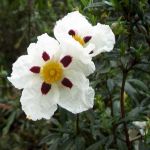| Common Name: |
Gum cistus |
| Botanical Name: |
Cistus ladanifer |
| Genus: |
Cistus |
| Family: |
Cistacea |
| Native Location: |
SW Europe to N Africa |
| Cultivation: |
Well-drained, light to poor soil in sun. Cut out dead wood in spring. Cistuses dislike hard pruning and transplanting. |
| Propagation: |
By seed sown when ripe, or in spring; by softwood or greenwood cuttings in summer. |
| Harvest: |
Leaves and twigs are collected in late spring and early summer for use in infusions, and boiled to extract oleo-resin. Oil is steam-distilled commercially from the oleo-resin. |
| Height: |
2-2,5m (6-8ft) |
| Width: |
.5m (5ft) |
| Hardiness: |
Z8-9 |
| Parts Used: |
Leaves, oleo-resin, oil. |
| Properties: |
An aromatic, stimulant, expectorant herb that controls bleeding and has anti-biotic effects. |
| Medicinal Uses: |
Internally for excess mucus and diarrhea. |
| Economic Uses: |
Used in Turkey as a fumigant. Important as a fixative in lavender, fern, and chypre perfumes, and as a commercial food flavoring for baked foods, soft drinks, ice cream, and candy. |
| Bibliography: |
Encyclopedia of Herbs by Deni Brown Copyright © 1995, 2001 Dorling Kindersley Limited Pg 170-171 |

